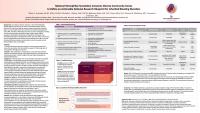NBDF considers the BDRC as an opportunity to address gaps in knowledge that can improve the lives of people affected by inheritable bleeding disorders. We want to ensure that the lived experience drives and influences the research process with consideration to equity, diversity, and inclusion so that research findings are relevant to all. To do that, community input is vital to every step of the process.

Considering the Possibilities: 2020/2021 Community Dialogue
In the summer of 2020, NBDF (formerly NHF) conducted an initiative called the Blue-Sky Project: Envisioning NBDF in 2030, which was conceived and led by then NHF CEO Leonard Valentino, MD. It involved a series of virtual listening sessions conducted in collaboration with the Center for Information and Study on Clinical Research Participation (CISCRP), and Tufts University Center of Study of Drug Development. These sessions included over one hundred participants from diverse groups representing adults with bleeding disorders, caregivers, other patient organizations, chapter and member organization directors, healthcare providers, federal partners, and industry representatives.
"As someone living with a rare bleeding disorder, it’s exciting to be involved in discussions about research that could benefit my life. I work in healthcare in an urban environment, and see so many opportunities to improve equal access to care for people with these and many other disorders.”
– Esmeralda Vazquez, Steering Committee patient representative
Important themes emerged from the sessions, reflecting common interests and needs from across the community.
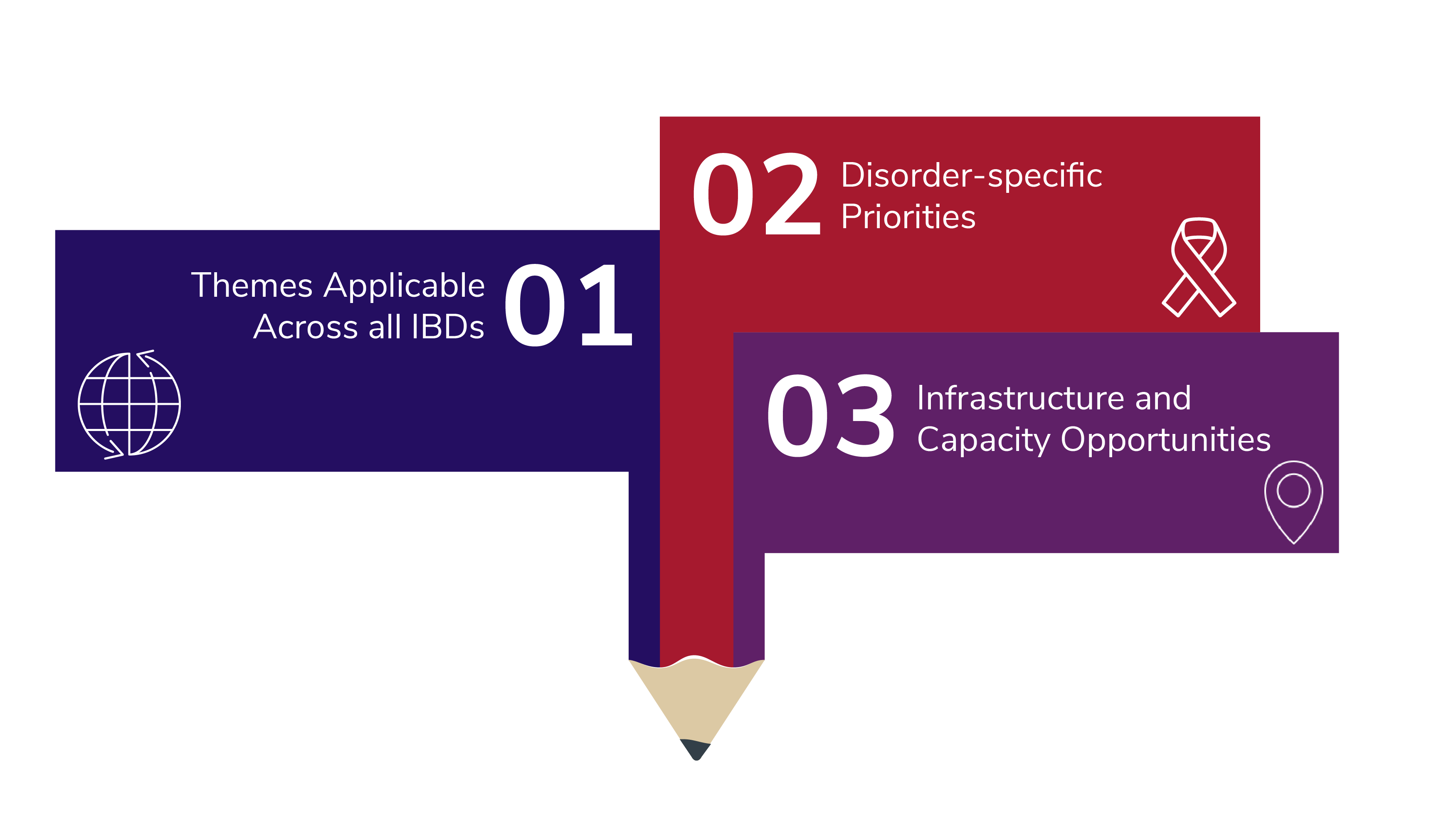
“Challenging aspects of living with a bleeding disorder still need more research focus, especially mental health given the social emotional, and physical challenges faced in everyday life.”
– Listening Session Participant
From that initial input, a cross-community survey was developed and launched in 2021 through NBDF’s chapters and Hemophilia Federation of America (HFA) member organizations to people with bleeding disorders and their family members. Additionally, the survey was distributed through NBDF’s networks to healthcare professionals. Special thanks to all those who participated in the survey.
View the community survey results here
September 2021 State of the Science (SOS) Research Summit
The collective input from the community engagement activities culminated in the virtual State of the Science (SOS) Research Summit in September 2021. During this Summit, each of the six diverse and interdisciplinary SOS working groups presented and ranked priority research questions in key areas of unmet need, embracing comments and questions from community representatives to uncover breakthrough challenges and opportunities. In total, more than 2,000 people presented, participated, or viewed this seminal summit, which highlighted key themes and areas of focus to shape the next phase of the journey.

Sincere thanks to the SOS Steering Committee and Working Group Chairs
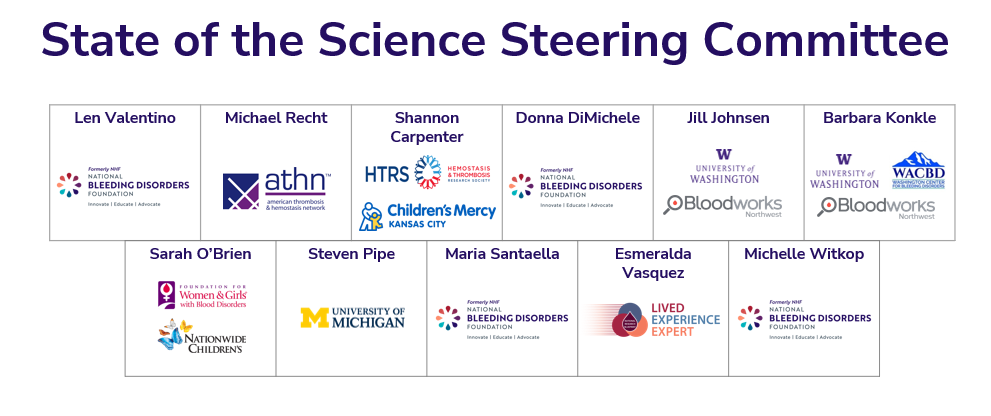

Defining our Priorities: 2021/2022 Working Groups
Using the themes collected from the 2021 summit, the NRB Steering Committee and working groups were established to draw the roadmap to the NRB.
Special thanks to the NRB Steering Committee and to NRB Working Group Chairs:
NRB Steering Committee:
- Halli Benasutti, PhD
- Samantha Carlson, LMSW
- Donna DiMichele, MD
- Keri Norris, PhD, JM, MPH, MCHES
- Michael Recht, MD, PhD
- Maria E Santaella, PhD(c), MSN, RN-BC, CPHON
- Sammie Valadez
- Len Valentino, MD
- Michelle Witkop, DNP
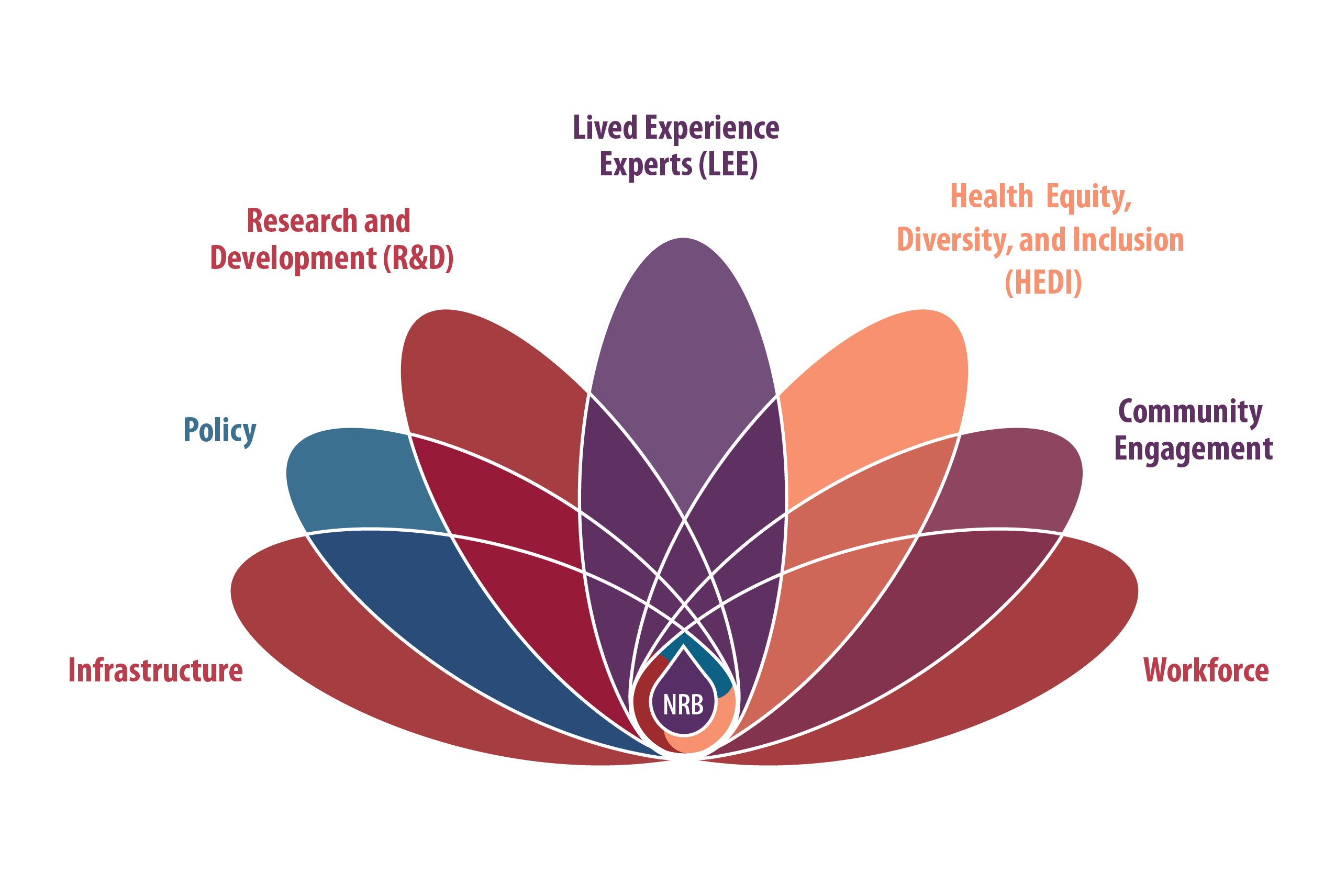
Adapted with permission from Vazquez E, Kim M,Santaella ME. Lived experience experts: a name created by us for us. Expert RevHematol. 2023;16(sup1):7-11.
Two in-person workshops in 2022 guided the next phase of the NRB. More than 100 LEEs, caregivers, patient organizations, chapter and member organization directors, healthcare providers, and industry representatives all provided input – most for the first time. During these workshops, participants discussed how to translate broad research themes into a clear, defined roadmap toward research progress. They assessed research questions identified by the community and prioritized them based on a defined set of feasibility criteria to help crystallize our opportunities and make the greatest impact on care for people with bleeding disorders.
The NRB defined and ranked research priorities, publishing them in a detailed supplement in 2023.
With preliminary concepts, more feedback was collected from across our community.
- The Research Department staff presented a Wednesday Webinar describing the NRB vision and providing context for the Open Comment Survey which launched at the end of 2023. See the results of that survey here.
- NRB Steering Committee members were interviewed for one episode of the Global Hemophilia Report podcast focused on the NRB.
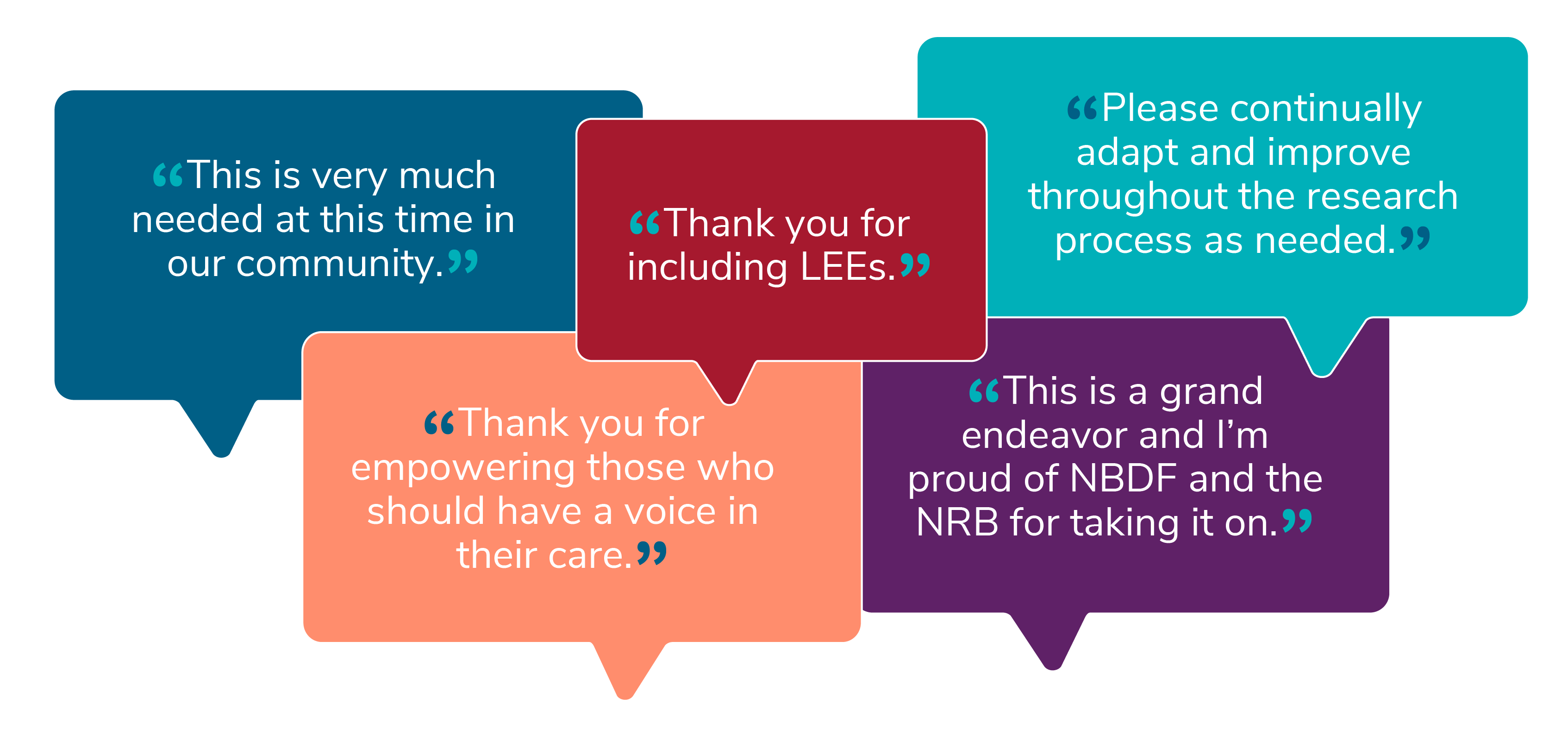
SOS Publications
Following more than a year of careful design, evaluation, community input, and prioritization, a series of manuscripts were published in a March 2023 supplement of the journal Expert Review of Hematology.
These papers describe each working group’s initial recommendations on how to activate the critical elements of the NRB. Importantly, they explain the collective efforts of each working group to translate the important ideas and identified unmet needs into tangible, feasible, and prescriptive guidance on how to improve research for the future.
NBDF extends sincere thanks to everyone on the SOS Steering Committee, Working Group chairs, and participants for their time and contributions to these important papers, each of which includes a simple language summary. The individual papers can be reviewed at the following links:
- Executive Summary: The National Hemophilia Foundation State of the Science Research Summit Initiative
- Foreword: The National Hemophilia Foundation’s state of the science research summit: the foundation of a national research blueprint for inherited bleeding disorders
- Working Group 1: Building the foundation for a community-generated national research blueprint for inherited bleeding disorders: Research priorities to transform the care of people with hemophilia
- Working Group 2: Building the foundation for a community-generated national research blueprint for inherited bleeding disorders: Research priorities for mucocutaneous bleeding disorders
- Working Group 3: Building the foundation for a community-generated national research blueprint for inherited bleeding disorders: Research priorities for ultra-rare inherited bleeding disorders
- Working Group 4: Building the foundation for a community-generated national research blueprint for inherited bleeding disorders: Research to advance the health of women and girls and people with inherited bleeding disorders with the potential to menstruate
- Working Group 5: Building the foundation for a community-generated national research blueprint for inherited bleeding disorders: Research priorities in health services; diversity, equity, and inclusion; and implementation science
- Working Group 6: Building the foundation for a community-generated national research blueprint for inherited bleeding disorders: Facilitating research through infrastructure, workforce, resources and funding
- Lived Experience Expert Editorial: Lived Experience Experts: A name created by us for us
- International Perspective: Soliciting international perspectives on an American national research agenda for inherited bleeding disorders
Organizing Themes into Priorities
Following the initial assessments and characterization completed by the SOS Working Groups, the NRB Research and Development group then evaluated this diverse group of research questions, reviewed them for gap areas, and translated the list to into broad topics while identifying areas of shared research interest across disorders and genders. This important work has defined the nine research priorities now established in the first iteration of the NRB.
January 2024 NRB Summit
With the combined input from community listening, the SOS summit, manuscripts, and workshops, the NRB working groups finalized and presented a series of recommendations for an integrated research enterprise during a community Summit in January 2024. The series of moderated panels and Q&As guided a robust conversation about the defined principles of the NRB and the critical elements that will be necessary as the implementation process begins.
The presentations for each of the working groups can be reviewed at the links below:
- Research and Development Working Group
- Infrastructure Working Group
- Workforce Working Group
- Community Engagement Working Group
- Lived Experience Expert Working Group
- Policy Working Group
- Health Equity, Diversity, and Inclusion Working Group
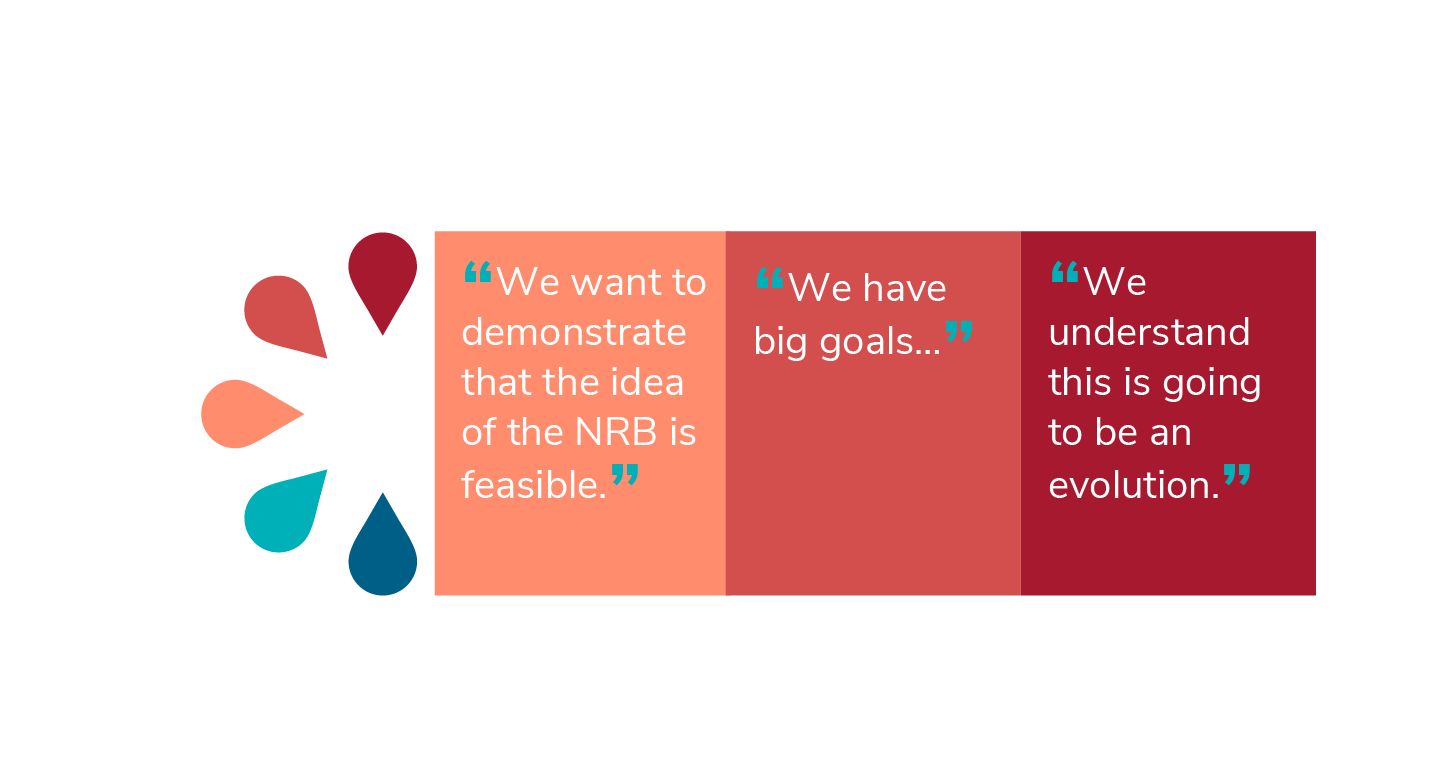
Special thanks! NBDF is extremely grateful to Veronica Robinson, David Lacks, Dr Eric Winer, Dr. Toby Lewis, and Zachary Rowe for their keynote presentations during the NRB Summit. Dr. Lewis and Mr. Rowe are doing remarkable and valuable research together within their local community. Their presentation about Community Based Participatory Research can be found here.
You can also review a late 2023 Wednesday Webinar during which the early draft of the NRB was presented by NBDF’s Research Department staff.
A special thank you to the Steering Committee and the Working Group Chairs and members, and all others who attended and contributed to the discussion.
What Lies Ahead?
Manuscripts describing the Summit proceedings and detailing the process that resulted in the initial recommendations are currently in development. A summary of the summit will be published later in 2024, and the full NRB recommendation manuscripts are anticipated to be published in 2025.
With the initial concept of the blueprint now established, the third phase of the NRB begins in 2024. A new Steering Committee is focused on fundraising, awareness, and infrastructure to begin piloting integrated research programs based on the defined priorities.
The process to build and expand the impact of an NRB will be iterative, which means we will test the effort with research partners, then listen, learn, and adapt to strengthen the network and improve its utility for everyone involved.
This is why community collaboration is so important! The NRB’s success depends on participation across the community so we can make a real difference in the future of care for bleeding disorders.
Join us on this next chapter of the NRB! Visit the “How to Get Involved” page or click to sign up for more information.
“No more one-off research projects. Having LEE's input, guidance, and insight at every level of the NRB will make research in the Bleeding Disorders Community better and more applicable to all.”
- Ray Stanhope, LEE
Laying the Foundation: The Current Step in Constructing the Bleeding Disorders Research Collaborative
NBDF's NRB has a new name: the BDRC. This update reflects how far this initiative has come and where it's headed. This change represents a shift from defining research priorities to implementing them through inclusive and equitable approaches. Most importantly, it reinforces NBDF's commitment to partnering with LEEs and centering their perspectives in the research that affects them most.
As the BDRC, the NRB moves from planning to execution - translating priorities into real-world studies and strategies to improve care, equity, and quality of life across the bleeding disorders community. The LEE Research Advisory Council is currently working to build out the BDRC infrastructure that will support the success of this endeavor. Learn more about these amazing community members and their work here.
Moving forward, NBDF's Research Team will work with the LEE Research Advisory Council to develop the systems and programs that will connect LEEs with researchers to pursue community-defined research priorities.


